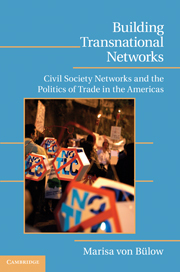Book contents
- Frontmatter
- Contents
- List of Figures
- List of Tables
- Acknowledgments
- Part One Civil Society Organizations and Their Pathways to Transnationality
- 1 INTRODUCTION
- 2 MULTIPLE PATHWAYS TO TRANSNATIONALITY
- Part Two The Politicization of Trade
- Part Three The Dynamics of Networks
- Part Four Organizational Pathways to Transnationality
- Part Five The Search for Ideational Pathways
- Main Abbreviations Used
- Appendix A Lists of Interviews
- Appendix B Social Network Questionnaire (United States)
- Bibliography
- Index
1 - INTRODUCTION
Published online by Cambridge University Press: 05 October 2010
- Frontmatter
- Contents
- List of Figures
- List of Tables
- Acknowledgments
- Part One Civil Society Organizations and Their Pathways to Transnationality
- 1 INTRODUCTION
- 2 MULTIPLE PATHWAYS TO TRANSNATIONALITY
- Part Two The Politicization of Trade
- Part Three The Dynamics of Networks
- Part Four Organizational Pathways to Transnationality
- Part Five The Search for Ideational Pathways
- Main Abbreviations Used
- Appendix A Lists of Interviews
- Appendix B Social Network Questionnaire (United States)
- Bibliography
- Index
Summary
When civil society organizations (CSOs) enter the realm of international relations, they make a decision that is fraught with uncertainty. Not only is there no blueprint for going global, but doing so requires skills and resources that are scarce for most actors. Different choices are available, and which is the best may not be obvious. The results often are ambiguous because actors become neither local nor global, and sometimes are both. This book is about the uncertainty and ambiguity that permeate collective action across different scales. It offers an analysis about when, and how, actors choose among multiple possible pathways to transnationality.
In 1969, James Rosenau called for the development of a linkage theory, supported by a research agenda on national-international flows of influence. The absence of such a theory was, according to the author, due both to the lack of communication between those who specialize in national politics and those who specialize in international relations, and to the radical revision of the standard conception of politics that this theoretical approach would entail (Rosenau 1969a: 8–10). Twenty-five years later, another prominent international relations scholar, Robert B. J. Walker, made a similar appeal to understand the politics of connection across spatial boundaries and the politics of movement, which should consider the changing contexts of political action through time (Walker 1994).
- Type
- Chapter
- Information
- Building Transnational NetworksCivil Society and the Politics of Trade in the Americas, pp. 3 - 19Publisher: Cambridge University PressPrint publication year: 2010

